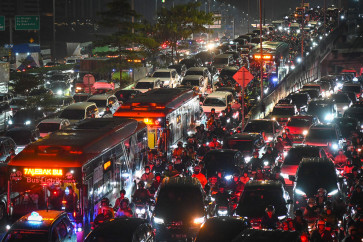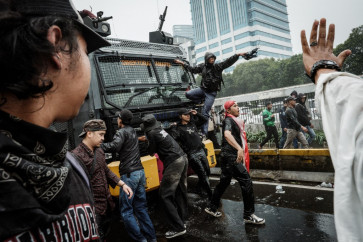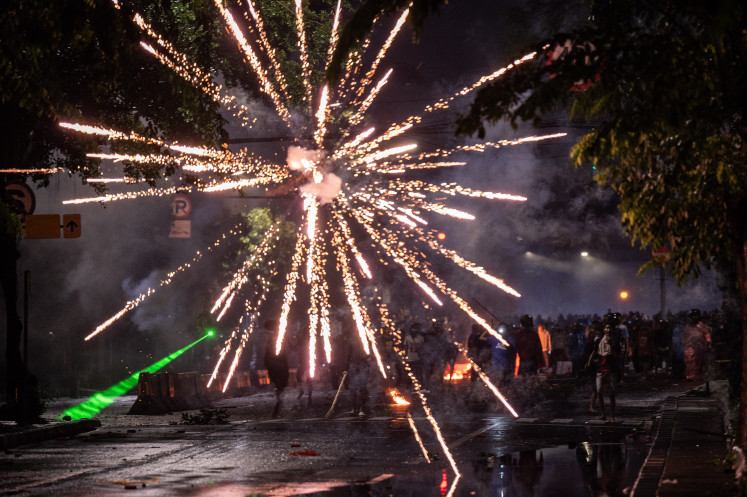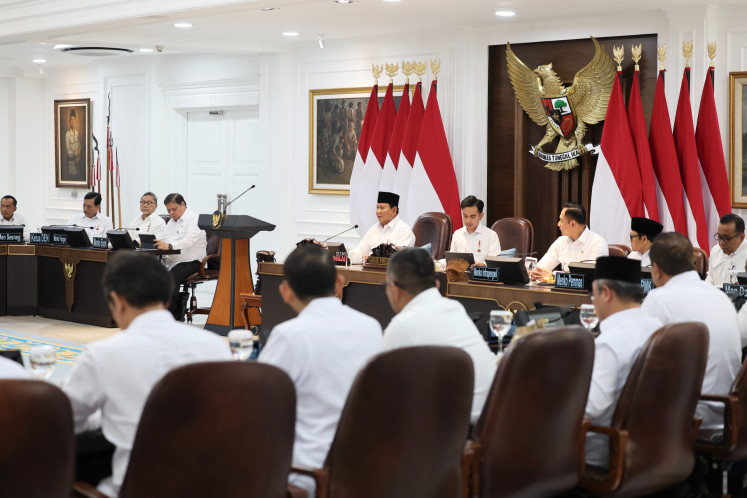Popular Reads
Top Results
Can't find what you're looking for?
View all search resultsPopular Reads
Top Results
Can't find what you're looking for?
View all search resultsGeorge Town: From ghost town to UNESCO world heritage
Work in progress: A Think City conservation project is under construction
Change text size
Gift Premium Articles
to Anyone
 Work in progress: A Think City conservation project is under construction. (JP/Dewanti Wardhani)" height="383" width="510" border="0">Work in progress: A Think City conservation project is under construction. (JP/Dewanti Wardhani)
Work in progress: A Think City conservation project is under construction. (JP/Dewanti Wardhani)" height="383" width="510" border="0">Work in progress: A Think City conservation project is under construction. (JP/Dewanti Wardhani)Located in the north-east corner of the island, George Town has a breathtaking view of the sea, overlooking Malaysiaâs mainland.
George Town, named after Britainâs King George III, is famous for its rows and rows of modest vintage buildings some of which were inherited from the British colonial era. Most of the buildings have been modified into conceptual shops and boutique hotels.
Foreign tourists can be seen on every corner of George Town, reading maps as they make their way around, getting a taste of the cityâs unique culture and diverse ethnicities.
Residents in George Town comprise three main ethnicities; Malay, Chinese and Indian. The cultures, food, religions and languages of each ethnicity can still be seen, tasted and heard in every corner of the city, which makes George Town attractive to foreign tourists.
Tourist destinations in George Town include the artsy Armenian Street, the center of budget hotels and restaurants on Chulia Street, and the Street of Harmony where St. Georgeâs Church, the Goddess of Mercy Temple, the Sri Maha Mariamman Kovil and the Kapitan Keling Mosque are situated.
The city has struggled to become what it is now; from a deserted city to a flourishing tourist destination.
Before it was named a UNESCO World Heritage Site in 2008 together with Malacca, George Town was an ailing city, abandoned by its residents who were burdened by high rents.
From 1967, buildings in George Town built before 1948 had been protected by the Rent Control Act, which limited the amount of rent a tenant had to pay to the buildingâs owner. However, in September
1997, the act was repealed and landlords drastically increased rents, chasing thousands of residents out of the city.
George Town became a ghost town with beautiful but decaying vintage buildings.
Leow Lim Shu Kuang, 57, who was born and raised in George Town, remembers what it was like before the city was popular among foreign tourists.
 True experience: A tourist looks to a boutique hotel. (JP/Dewanti Wardhani)
True experience: A tourist looks to a boutique hotel. (JP/Dewanti Wardhani)
âIt was really quiet back then. There were no foreign tourists at all. The streets were empty. George Town is still a quiet town now, you can only imagine how it was back then,â Leow said.
Leow along with his wife, mother and children were among the few who survived in George Town after the Rent Control Act was repealed. They all lived in a shop house in Armenian Street, now a tourist destination in the city, popular for its street art.
Leow and his family opened a t-shirt business in 2010, selling shirts to tourists as souvenirs. âIt was my motherâs idea. She saw that there were many foreign tourists and predicted that they would keep coming. And she was right,â he said.
Today, his mother, now 79 years old, always wakes earliest in the morning to open the shop. âSheâs
always excited to open the shop now. She says she feels younger than ever since foreign tourists started coming to George Town,â Leow said.
Once George Town was named a world heritage site, the city was given a RM 20 million (US$6 million) grant from the central government to preserve its vintage buildings, while Malacca, a smaller city in size, received RM 30 million.
The grant is now managed by Think City, a subsidiary of state-owned Khazanah Nasional Berhad, a company entrusted with holding and managing the commercial assets of the government and to undertake strategic investments.
Think City provides up to 20 percent funding for individual projects and up to 80 percent for community-based projects.
Work in progress: A Think City conservation project is under construction. (JP/Dewanti Wardhani) Located in the north-east corner of the island, George Town has a breathtaking view of the sea, overlooking Malaysia's mainland. True experience: A tourist looks to a boutique hotel. (JP/Dewanti Wardhani) A stroll through history: Tourists walk along Armenian Street. (JP/Dewanti Wardhani)
George Town, named after Britain's King George III, is famous for its rows and rows of modest vintage buildings some of which were inherited from the British colonial era. Most of the buildings have been modified into conceptual shops and boutique hotels.
Foreign tourists can be seen on every corner of George Town, reading maps as they make their way around, getting a taste of the city's unique culture and diverse ethnicities.
Residents in George Town comprise three main ethnicities; Malay, Chinese and Indian. The cultures, food, religions and languages of each ethnicity can still be seen, tasted and heard in every corner of the city, which makes George Town attractive to foreign tourists.
Tourist destinations in George Town include the artsy Armenian Street, the center of budget hotels and restaurants on Chulia Street, and the Street of Harmony where St. George's Church, the Goddess of Mercy Temple, the Sri Maha Mariamman Kovil and the Kapitan Keling Mosque are situated.
The city has struggled to become what it is now; from a deserted city to a flourishing tourist destination.
Before it was named a UNESCO World Heritage Site in 2008 together with Malacca, George Town was an ailing city, abandoned by its residents who were burdened by high rents.
From 1967, buildings in George Town built before 1948 had been protected by the Rent Control Act, which limited the amount of rent a tenant had to pay to the building's owner. However, in September
1997, the act was repealed and landlords drastically increased rents, chasing thousands of residents out of the city.
George Town became a ghost town with beautiful but decaying vintage buildings.
Leow Lim Shu Kuang, 57, who was born and raised in George Town, remembers what it was like before the city was popular among foreign tourists.
'It was really quiet back then. There were no foreign tourists at all. The streets were empty. George Town is still a quiet town now, you can only imagine how it was back then,' Leow said.
Leow along with his wife, mother and children were among the few who survived in George Town after the Rent Control Act was repealed. They all lived in a shop house in Armenian Street, now a tourist destination in the city, popular for its street art.
Leow and his family opened a t-shirt business in 2010, selling shirts to tourists as souvenirs. 'It was my mother's idea. She saw that there were many foreign tourists and predicted that they would keep coming. And she was right,' he said.
Today, his mother, now 79 years old, always wakes earliest in the morning to open the shop. 'She's
always excited to open the shop now. She says she feels younger than ever since foreign tourists started coming to George Town,' Leow said.
Once George Town was named a world heritage site, the city was given a RM 20 million (US$6 million) grant from the central government to preserve its vintage buildings, while Malacca, a smaller city in size, received RM 30 million.
The grant is now managed by Think City, a subsidiary of state-owned Khazanah Nasional Berhad, a company entrusted with holding and managing the commercial assets of the government and to undertake strategic investments.
Think City provides up to 20 percent funding for individual projects and up to 80 percent for community-based projects.
Driven by passionate conservationists and architects, Think City has been one of the main vehicles behind George Town's urban regeneration.
Tan Yeow Wooi, a conservationist who worked with Think City, said that the business of urban regeneration in George Town was expensive and quite difficult.
He said there were around 5,500 buildings in George Town, 3,700 of which were categorized as heritage buildings. Architects were prohibited from building higher than five stories in George Town.
'Renovating shop houses could cost from RM 300,000 to a whopping RM 800,000. The cost of conservation is expensive,' Tan said.
He added that working as a conservationist in George Town was a challenge.
'It is quite difficult to maintain the balance between sustaining the intangible culture and renovating the building right on budget,' Tan said.
Neil Khor, a senior fellow at Think City, said that he was passionate about the urban regeneration project in George Town, as he was born and raised in Penang.
'This project is very close to my heart. Although we still have many challenges to overcome, at the end of the day I think we left George Town a little better than it was before,' he said.
Your Opinion Matters
Share your experiences, suggestions, and any issues you've encountered on The Jakarta Post. We're here to listen.
Thank You
Thank you for sharing your thoughts. We appreciate your feedback.
Share options
Quickly share this news with your network—keep everyone informed with just a single click!
Gift Premium Articles
to Anyone
Share the best of The Jakarta Post with friends, family, or colleagues. As a subscriber, you can gift 3 to 5 articles each month that anyone can read—no subscription needed!
Continue in the app
Get the best experience—faster access, exclusive features, and a seamless way to stay updated.









